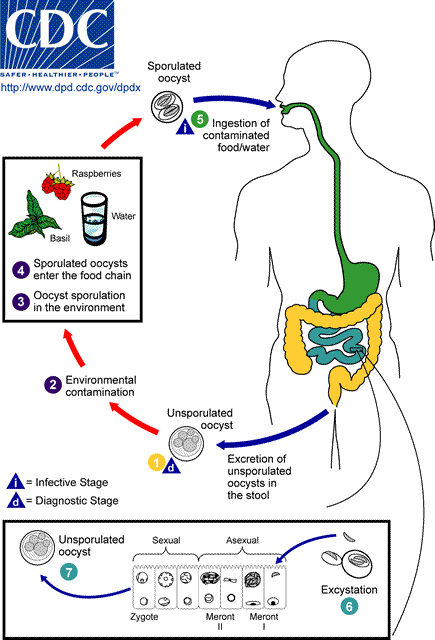Cyclosporiasis pathophysiology
|
Cyclosporiasis Microchapters |
|
Diagnosis |
|---|
|
Treatment |
|
Case Studies |
|
Cyclosporiasis pathophysiology On the Web |
|
American Roentgen Ray Society Images of Cyclosporiasis pathophysiology |
|
Risk calculators and risk factors for Cyclosporiasis pathophysiology |
Editor-In-Chief: C. Michael Gibson, M.S., M.D. [1]; Associate Editor(s)-in-Chief: João André Alves Silva, M.D. [2]
Overview
Pathogenesis
Life Cycle
Unsporulated oocysts of Cyclospora cayetanensis are excreted from infected persons. When freshly passed in stool, the oocyst is not infective (thus, direct fecal-oral transmission cannot occur, which differentiates Cyclospora from other important coccidian parasites such as Cryptosporidium). Under adequate temperatures (23-32ºC), these take about 7-15 days to sporulate, in order to become infectious. After being ingested, from contaminated water and/or food, oocysts excyst to release elongated sporozoites. Sporozoites will then infect epithelial cells of the gastrointestinal tract, particularly those of the duodenum and jejunum. The sporozoites undergo asexual reproduction, originating meronts type I and II, which will then differentiate into gametocytes. These last, will be fertilized to produce a zygote.[1][2] Inside cells, zygote undergo asexual reproduction and development to mature into oocysts, which will be shed in stool.[3]
C. cayetanensis oocysts have also been isolated from non-gastrointestinal sites, such as sputum, especially in immunocompromised patients with HIV and concomitant TB. This leads to the hypothesis that C. cayetanensis may be an opportunistic pathogen.[4]

Transmission
C. cayetanensis is transmitted through the fecal-oral route. People are infected with Cyclospora by ingesting sporulated oocysts (infective form of the parasite). This occurs most commonly when food or water contaminated with feces is consumed. The parasite is shed in the feces of infected persons in the oocyst form (non-infective). It will then take days to weeks, in a favorable environment, to sporulate and become infective. Therefore, direct person-to-person transmission is unlikely, as is transmission via ingestion of newly contaminated food or water.[3][2]
Pathology
C. cayetanensis infects epithelial cells of the small intestine, especially those of the jejunum. Infected patients showed evidence of intestinal injury on endoscopy, such as erythema of the mucosa.
Histologic samples of small bowel of these patients showed affection of the lamina propria, with moderate inflammation of this region, and neutrophils in some cases. All studied patients had evidence of chronic inflammation, with identification of plasma cells in the mucosa.[5]
The infected epithelial cells of the gastrointestinal tissue include the following alterations:[5][2]
- Vacuolization of the tips of the villi
- Mucosal changes with loss of brush border appearance
- Epithelial changes from columnar to cuboid
- Villous atrophy (partial)
- Crypt hyperplasia
- Absence of parasitic vacuoles in biopsied samples
Immunocompromised patients are more prone to develop chronic inflammation of the epithelium of gastrointestinal tract.[2]
References
- ↑ Eberhard ML, Ortega YR, Hanes DE, Nace EK, Do RQ, Robl MG; et al. (2000). "Attempts to establish experimental Cyclospora cayetanensis infection in laboratory animals". J Parasitol. 86 (3): 577–82. doi:10.1645/0022-3395(2000)086[0577:ATEECC]2.0.CO;2. PMID 10864257.
- ↑ 2.0 2.1 2.2 2.3 Ortega YR, Sanchez R (2010). "Update on Cyclospora cayetanensis, a food-borne and waterborne parasite". Clin Microbiol Rev. 23 (1): 218–34. doi:10.1128/CMR.00026-09. PMC 2806662. PMID 20065331.
- ↑ 3.0 3.1 3.2 "Cyclosporiasis".
- ↑ Di Gliullo AB, Cribari MS, Bava AJ, Cicconetti JS, Collazos R (2000). "Cyclospora cayetanensis in sputum and stool samples". Rev Inst Med Trop Sao Paulo. 42 (2): 115–7. PMID 10810327.
- ↑ 5.0 5.1 Connor BA, Shlim DR, Scholes JV, Rayburn JL, Reidy J, Rajah R (1993). "Pathologic changes in the small bowel in nine patients with diarrhea associated with a coccidia-like body". Ann Intern Med. 119 (5): 377–82. PMID 8338291.